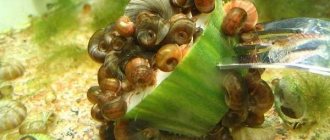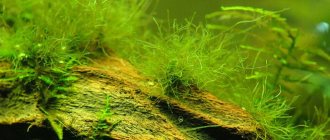A controlled snail population in a home aquarium is good and beneficial. They clean the walls of the tank, eat excess food, dead fish and rotten plants. And some of them also have a certain decorative effect. But one day there may be an obscene number of these slow-moving underwater inhabitants. Coils and melania especially often cause problems. We’ll share working methods on how to get rid of snails in an aquarium, and at the same time tell you how they get there and what harm they can cause.
Description
Acrolux snails come from the family Acroloxidae, and are the smallest representatives of freshwater aquarium mollusks. Their appearance is far from generally accepted ideas about aquarium snails: a flat, transparent, oval-shaped shell, up to 5 mm in size.
Under the shell-cap there is a small body of the snail. It is clearly visible through the transparent coating. When viewed from the side, a pointed apex is visible at the shell.
Small acroluxes lead a rather hidden life, and are active only in the dark. When you turn on the light at night, hundreds of snails will be found on the walls of the aquarium and the surface of the plants.
Novice aquarists often mistake acrolux for the North American mollusk Ferrissia fragilis, which is considered to be a weed snail. The difference between Acrolux and Ferrissia is in size (the latter is several millimeters larger) and the shape of the shell, which has a different slope. But even experienced aquarium owners cannot always say for sure what exactly started in it and began to multiply at a rapid pace.
Diseases and other problems
Sometimes improper maintenance leads to problems with the health of the mollusk. These problems can be solved quickly, the main thing is to notice the symptoms in time.
Coma
If the mollusk is alive, but does not protrude from the “house,” most likely it has fallen into a so-called coma. The only reason for this is a severe lack of oxygen. It is necessary to temporarily place the snail in a jar, enrich the water with oxygen, and at the same time resolve the issue of aeration of the main aquarium.
Losing a body part
With increased activity or during a skirmish with neighbors, the ampularia may lose its tactile organ or even its eyes. Like other mollusks, it has the ability to regenerate, so in a month the organ will be fully restored.
Shell damage
Dents, cracks and similar deformations of the shell indicate a lack of calcium in the snail’s body. To help it, you need to add natural chalk, eggshells or shells to the water - all in crushed form. Sepia, the cuttlefish skeleton that ampullaria love to scrape, will become a constant source of nutrients.
Parasites on the sink
The most common parasite is the tick. It is easy to recognize by the indentations that appear on the “house”. The infected snail must be removed from the water, wiped and treated with a solution of formaldehyde, applying the substance to a cotton pad. All individuals with tick symptoms must be treated.
White fluff on the “house”
Other parasites look like a white coating on the shell. A saline solution (10 grams per liter) will help to cope with it, where you need to place the ampoule for no more than 15 minutes.
Corrosion
Exceeding the temperature of the water can lead to corrosion of the shell. You will have to work hard with this problem: you can get rid of the disease no earlier than 3 months. The main thing is that all this time the mollusk is in water whose temperature does not go beyond 22 degrees.
Loss of activity
Snails are fairly passive creatures, and staying in one place for a long time is normal for them. The only thing that can cheer them up is food. If the tasty treat does not “revive” the ampularia, it is worth checking the water (low temperatures lead to hibernation of the mollusk).
The snail has surfaced
It’s easy to check if everything is okay with your pet in this case. Take the snail out of the water: if it immediately opens up, everything is fine, and it just swam to breathe oxygen from the air. A dead individual's muscles do not work, so it will not move.
Reasons for the appearance of acroluxes
The reasons for the appearance of acroluxes in the aquarium lie in its contamination. It is usually caused by excess shrimp or fish food. The remains of unused food pollute the water, giving rise to the development of small mollusks. They will eat up the remaining organic matter behind their larger neighbors. This is precisely their benefit; they clean the water and walls of the aquarium.
The amount of excess food in the aquarium is directly proportional to the number of shellfish that will eat it. The more organic matter, the more snails will appear.
There is a simple answer to the question “how to get rid of acroluxes”. To do this, reduce the amount of fish food to the required minimum. Then the miniature “orderlies” will disappear on their own.
Fizy
Physae are small and very mobile snails. These mollusks have very thin shells. The mantles protruding from the shells in some species of physes may have a bizarre color. Like the other described species, these snails are pulmonate. But the folds of the mantle function as gills, so the mollusks can remain under water for a long time.
Fizy.
Fiz are sometimes eaten by fish, but they do it without enthusiasm. Physes feed on plants, and in large quantities, so their presence in aquariums with live plants is undesirable.
How to get rid of acroluxes
Many people are interested in how to get rid of acroluxes in an aquarium, given that these mollusks are not like that - you can simply tear them off the glass.
Getting rid of acroluxes makes sense only when there are too many of them, and through the glass dotted with mollusks it becomes difficult to see the fish. In other cases, there is no need to fight them. They will not harm other inhabitants of the home pond.
On various forums where the stages of combating these invertebrates are described, you can read different ways to get rid of their presence.
- Some advise cleaning them off the glass with a stiff brush, while others suggest using a frying pan spatula.
- There are also those who crush them with their fingers or even send Helen’s predatory snails to war with the mollusks.
- As practice shows, mechanical methods of combating acroluxes are not effective. Even after completely cleaning the aquarium glass from them, they will appear again after a short time. It should be understood that a significant portion of snails can hide in plants.
- A chemical way to get rid of acrolux involves the use of copper-based compounds. But they should be used with extreme caution so as not to destroy the plants.
In any case, you need to make a choice in favor of common sense. Then it will become obvious that getting rid of an annoying, but generally harmless mollusk, will not be worth it to destroy the vegetation in your aquarium.
If there are shrimp in the aquarium, chemical methods of combating acrolux cannot be used: this will destroy them.
So, the main reason why acroluxes appear in an aquarium is its contamination. You should not overfeed the fish, and the number of “uninvited guests” will noticeably decrease. The predator snail Helena can also help correct the situation. It has been noticed that in its presence the number of mollusks is significantly reduced.
Snails (gastropods) are found in almost every aquarium. Some snails are simply uninvited guests, while others are real favorites of their owners. Is there any benefit to snails? Yes, but not from everyone. Therefore, first, let’s figure out what aquarium snails are.
Prudoviki
These mollusks live all over the world. They most often end up in aquariums with tropical plants, so they are not uncommon. Fish eagerly eat these mollusks and their eggs. Pond caviar looks like curved thick sausages. The testicles are bluish, white dots are visible in them - developing embryos that crawl along the walls of the egg, and the internal sac of the embryo already has the shape of a spiral.
Pond fish are the orderlies of the aquarium.
Pond fish are not desirable inhabitants of aquariums. They do not bring any benefit, but can, on the contrary, damage plants. Domestic pond snails can be quite large in size - shells can reach 5 centimeters. Naturally, they should never be brought into aquariums on purpose, as they will begin to destroy plants and can infect fish with trematode larvae.
Acrolux - who is he?
You may have often noticed how, from time to time, strange flat creatures that look like snails appear on the glass of your aquarium. In fact, these are snails - acroluxes!
Acroluxus is a mollusk, a transparent snail that lives in fresh water. The size of these small flat snails does not exceed 5 mm.
There is a very similar species to Acrolux - Ferrisia, individuals of which grow up to 7 mm, but it is unlikely that you will be able to find out exactly what has started and is actively reproducing in your aquarium.
Acrolux – harm or benefit?
These snails do not harm the inhabitants of the aquarium. The harm can only be aesthetic, especially if the acroluxes have managed to proliferate considerably. You will notice this, as the mollusks begin to actively crawl onto the walls and glass of the aquarium.
The main reason for the occurrence of these snails is considered to be overfeeding in the aquarium! For them, this is an excellent incentive to reproduce, and for you, this is a sign that it’s time to put your fish on a diet that is not just a temporary one.
How to get rid of acrolux
In general, there is no particular point in getting rid of them, unless there are very many of them. But if the sight of the glass in your aquarium, which is dotted with tiny snails, really bothers you, then you can try to fight them.
What people come up with in the fight against acroluxes... Some try to scrub with a glass cleaning brush, some press with their fingers, and some even use a frying pan spatula. These methods may work on glass, but on plants they will not help at all.
However, there is a method to destroy acrolux using chemistry - using preparations containing copper - Cu. For example, fertilizers. However, when using chemicals there is a danger of poisoning the plants; if you do this, be sure to monitor the quality of the water in the aquarium. Therefore, as always, you need to set priorities - what is more important for you at the moment: saving the plants or getting rid of a harmless but annoying mollusk...
Snails: benefits and harm from them in aquariums
Snails are found in almost every aquarium. Some snails settle in the aquarium on their own, while others are brought in on purpose, and they become real favorites of aquarists. Are snails beneficial? They do, but not all types.
Acroluxes
The smallest representatives of aquarium snails are acroluxes. These babies prefer to lead a hidden lifestyle, so they are active in twilight or darkness. If you turn on the light at night, you can see many hundreds of these small snails sitting on the glass of the aquarium and the leaves of plants. Don't be scared, these snails are harmless.
But the high number of acroluxes indicates that the aquarium contains a large amount of organic substances. After all, they feed on organic matter. Perhaps this situation is associated with overfeeding the fish. If you reduce the amount of food, then the number of shellfish will decrease.
Acrolux in an aquarium.
In spawning grounds where eggs develop, there should be no acroluxes, since they damage the eggs. These snails are beneficial because they are an indicator of water pollution.
Horn Coils
These snails are found in nature and placed in aquariums; the coils themselves are not placed in them. Horn coils look solid and have textured shells. These mollusks have pulmonary respiration, so they are able to survive even in polluted stagnant water. They can also breathe underwater using a mantle that replaces gills.
In nature, these mollusks mainly feed on algae. In aquariums, coils are beneficial because they eat algae deposits that envelop glass and plants. But these snails are not very diligent cleaners. They do not clean the aquarium completely, but only make winding paths that are clearly visible on the glass.
It is worth considering that horn coils have rather hard graters with which they collect food, so they can injure soft plants. In addition, these mollusks carry helminthic diseases that are dangerous for fish and warm-blooded animals. Parasitic worms have a complex development cycle and the primary hosts are horny coils. When the worms leave the shellfish, they move into the fish, infecting it. This is why it is not worth keeping horned coils in aquariums.
Horn coils.
These snails are hermaphrodites, so just two individuals are enough for them to reproduce in huge numbers. If these snails starve, they do not disappear, but become much smaller. Many fish like the meat of horny coils, for example, macropods and bettas purposefully hunt for them; they wait a long time until the snail sticks out of the shell, grab it and drag it away.
Are there any benefits to horn coils? It is better not to keep them in the aquarium, and if these mollusks do breed, they will have to be caught regularly.
Prudoviki
These mollusks live all over the world. They most often end up in aquariums with tropical plants, so they are not uncommon. Fish eagerly eat these mollusks and their eggs. Pond caviar looks like curved thick sausages. The testicles are bluish, white dots are visible in them - developing embryos that crawl along the walls of the egg, and the internal sac of the embryo already has the shape of a spiral.
Pond fish are the orderlies of the aquarium.
Pond fish are not desirable inhabitants of aquariums. They do not bring any benefit, but can, on the contrary, damage plants. Domestic pond snails can be quite large in size - shells can reach 5 centimeters. Naturally, they should never be brought into aquariums on purpose, as they will begin to destroy plants and can infect fish with trematode larvae.
Fizy
Physae are small and very mobile snails. These mollusks have very thin shells. The mantles protruding from the shells in some species of physes may have a bizarre color. Like the other described species, these snails are pulmonate. But the folds of the mantle function as gills, so the mollusks can remain under water for a long time.
Fizy.
Fiz are sometimes eaten by fish, but they do it without enthusiasm. Physes feed on plants, and in large quantities, so their presence in aquariums with live plants is undesirable.
Malayan sand snails or melania
These mollusks are viviparous. It is enough to have just one such snail in the aquarium, so that after a while there will be a whole herd of them. Females can reproduce without fertilization.
Melanias for aquariums are useful inhabitants. As a rule, they are almost invisible; they dig into the soil and feed on bacterial fouling and organic matter. These snails are not interested in living plants. They pick up decaying pieces of food and constantly loosen the soil, which is very good. Melania prevents the development of hydrogen sulfide in the soil, which is very dangerous for fish.
These mollusks do not have lungs, so they do not need to rise to the surface and breathe. Respiration occurs through gills. Melanias carry out their activities in the soil, and in the soil a large number of substances are processed. If there is not enough oxygen in the soil and it begins to suffocate, the melania will immediately feel it. Organic substances harmful to fish will accumulate in the water of the aquarium only after a few days, and the melania will already show that something is wrong, as they will leave the ground and begin to crawl on the glass. This will be a signal for the aquarist, and he will be able to save the aquarium inhabitants by siphoning the soil or increasing the filtration and aeration of the water.
Not all snails are beneficial to aquarium residents.
So there are great benefits from melania in the aquarium. But there is one drawback - these mollusks reproduce extremely quickly. They can multiply so much that the soil begins to move. For an aquarium, a large number of melania is not bad, but the mollusks will begin to starve and climb onto the glass of the aquarium in search of food. If you turn on the lights suddenly at night, many thousands of them can appear on the glass.
Melania larvae will have to be caught. It is recommended to do this in the evening, when they leave the ground.
If you find an error, please select a piece of text and press Ctrl+Enter.
animalreader.ru











